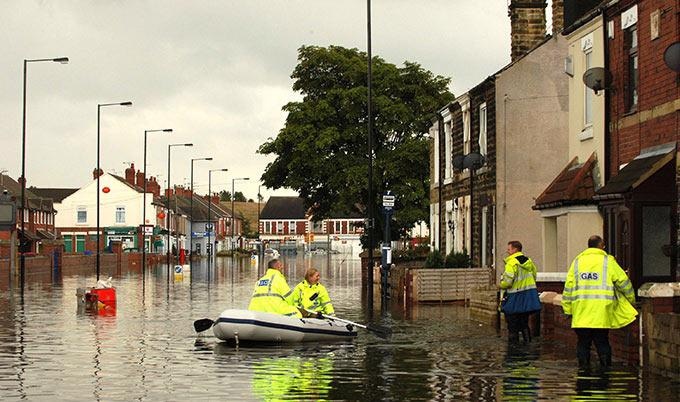A detailed study on the intense rainfall patterns induced by climate variations, throughout Europe, has revealed that there might be a notable increase in the occurrence of slow-moving intense rainstorms in the future. The study was performed by climate experts.

Image Credit: Newcastle University.
Scientists have predicted that by the end of the 21st century, the slow-moving storms might grow 14 times more often across the land. Such slow-moving storms have the ability to gather high precipitation, thereby causing destructive impacts, similar to the ones that took place in Belgium and Germany.
The study was headed by Dr. Abdullah Kahraman from the School of Engineering at the Newcastle University (NU). The researchers employed an elaborate climate model simulation at the UK Met Office Hadley Center.
They discovered that slower storm movements are responsible for the increase in the volume of rainfall that gets accumulated locally. This results in the high risk of flash floods throughout Europe, surpassing the predictions made in earlier studies.
The results obtained from the study illustrate that the storms generating intense rain might slow down with climate change, which increases the span of exposure to these extremes. The study was reported in the journal Geophysical Research Letters.
A Wake-Up Call
With recent advances in supercomputer power, we now have pan-European climate simulations resolving the atmosphere in high detail as short-range weather forecasting models do. These models have grid spacing of approximately 2 km, which allows them to simulate storm systems much better, resulting in better representation of extremes.
Dr. Abdullah Kahraman, Study Corresponding Author, School of Engineering, Newcastle University
Dr. Abdullah Kahraman is also a visiting scientist at the UK Met Office Hadley Center.
Dr. Kahraman continued, “Using these state-of-the-art climate simulations, we have developed metrics to extract potential cases for heavy rainfall, and a smaller, almost-stationary subset of these cases with the potential for high rainfall accumulations. These metrics provide a holistic view of the problem, and help us understand which factors of the atmosphere contribute to heavy rainfall changes.”
“This is one of the first studies to explore changes in the speed of such heavy rainfall systems – an important aspect contributing to flood risk. Currently, we are also investigating other extreme weather types by examining the climate simulations data with a severe weather forecaster’s perspective,” added Dr. Kahraman.
Governments across the world have been too slow in reducing greenhouse gas emissions and global warming continues apace. This study suggests that changes to extreme storms will be significant and cause an increase in the frequency of devastating flooding across Europe.
Hayley Fowler, Professor, School of Engineering, Newcastle University
“This, alongside the current floods in Europe, is the wake-up call we need to produce improved emergency warning and management systems, as well as implementing climate change safety factors into our infrastructure designs to make them more robust to these severe weather events,” added Professor Fowler.
This study shows that in addition to the intensification of rainfall with global warming, we can also expect a big increase in slow-moving storms which have the potential for high rainfall accumulations. This is very relevant to the recent flooding seen in Germany and Belgium, which highlights the devastating impacts of slow-moving storms.
Lizzie Kendon, Professor, Bristol University
“Our finding that slow-moving intense rainstorms could be 14 times more frequent by the end of the century under the high emissions RCP8.5 scenario, shows the serious impacts that we may expect across Europe if we do not curb our emissions of greenhouse gases,” added Prof. Kendon added, who is also a science fellow at the Met Office.
The results obtained are applicable to the European climate mitigation and adaptation policy. It has certain implications for future flooding impacts, management of water resources and also the design of infrastructure.
At present, nearly stationary intense rainstorms are less common in Europe and occur rarely over the regions of the Mediterranean Sea. Therefore, precisely predicting the future changes in intense rainfall patterns is essential to devise effective adaptation and mitigation plans in order to curb the adverse effects of climate change.
Journal Reference:
Kahraman, A., et al. (2021) Quasi-Stationary Intense Rainstorms Spread Across Europe Under Climate Change. Geophysical Research Letters. doi.org/10.1029/2020GL092361.